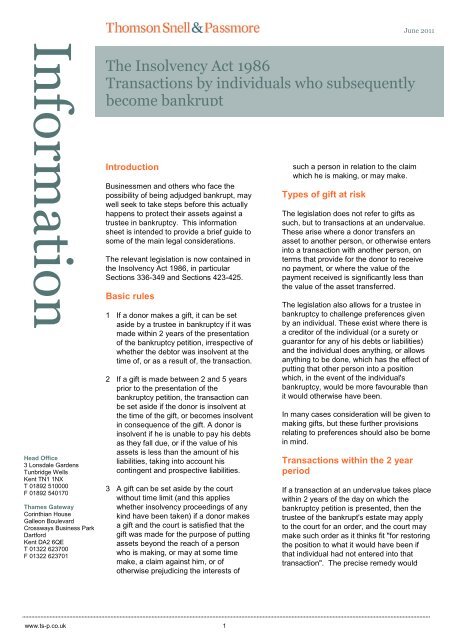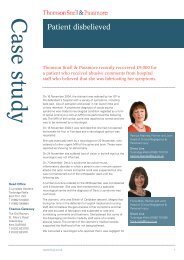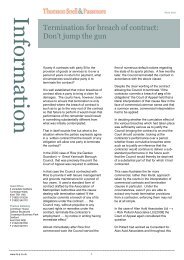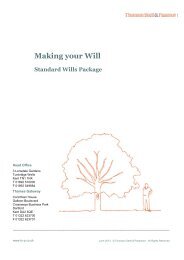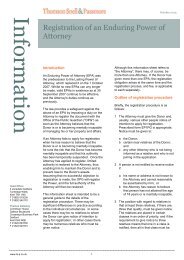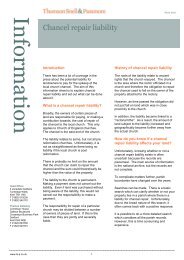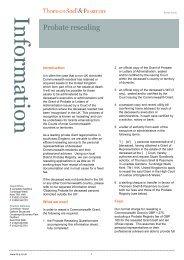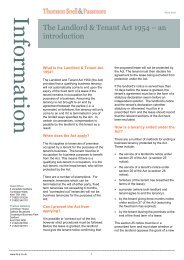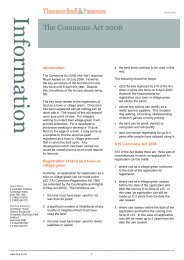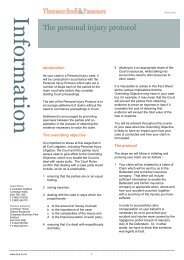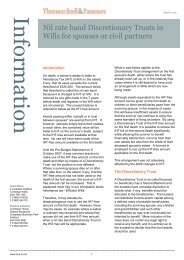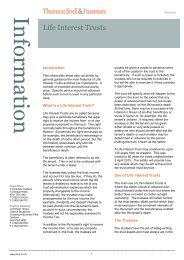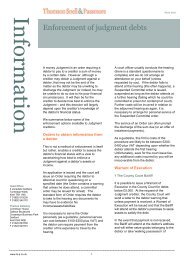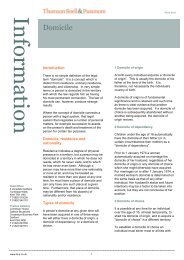The Insolvency Act 1986 Transactions by individuals who ...
The Insolvency Act 1986 Transactions by individuals who ...
The Insolvency Act 1986 Transactions by individuals who ...
You also want an ePaper? Increase the reach of your titles
YUMPU automatically turns print PDFs into web optimized ePapers that Google loves.
Information<br />
June 2011<br />
<strong>The</strong> <strong>Insolvency</strong> <strong>Act</strong> <strong>1986</strong><br />
<strong>Transactions</strong> <strong>by</strong> <strong>individuals</strong> <strong>who</strong> subsequently<br />
become bankrupt<br />
Head Office<br />
3 Lonsdale Gardens<br />
Tunbridge Wells<br />
Kent TN1 1NX<br />
T 01892 510000<br />
F 01892 540170<br />
Thames Gateway<br />
Corinthian House<br />
Galleon Boulevard<br />
Crossways Business Park<br />
Dartford<br />
Kent DA2 6QE<br />
T 01322 623700<br />
F 01322 623701<br />
Introduction<br />
Businessmen and others <strong>who</strong> face the<br />
possibility of being adjudged bankrupt, may<br />
well seek to take steps before this actually<br />
happens to protect their assets against a<br />
trustee in bankruptcy. This information<br />
sheet is intended to provide a brief guide to<br />
some of the main legal considerations.<br />
<strong>The</strong> relevant legislation is now contained in<br />
the <strong>Insolvency</strong> <strong>Act</strong> <strong>1986</strong>, in particular<br />
Sections 336-349 and Sections 423-425.<br />
Basic rules<br />
1 If a donor makes a gift, it can be set<br />
aside <strong>by</strong> a trustee in bankruptcy if it was<br />
made within 2 years of the presentation<br />
of the bankruptcy petition, irrespective of<br />
whether the debtor was insolvent at the<br />
time of, or as a result of, the transaction.<br />
2 If a gift is made between 2 and 5 years<br />
prior to the presentation of the<br />
bankruptcy petition, the transaction can<br />
be set aside if the donor is insolvent at<br />
the time of the gift, or becomes insolvent<br />
in consequence of the gift. A donor is<br />
insolvent if he is unable to pay his debts<br />
as they fall due, or if the value of his<br />
assets is less than the amount of his<br />
liabilities, taking into account his<br />
contingent and prospective liabilities.<br />
3 A gift can be set aside <strong>by</strong> the court<br />
without time limit (and this applies<br />
whether insolvency proceedings of any<br />
kind have been taken) if a donor makes<br />
a gift and the court is satisfied that the<br />
gift was made for the purpose of putting<br />
assets beyond the reach of a person<br />
<strong>who</strong> is making, or may at some time<br />
make, a claim against him, or of<br />
otherwise prejudicing the interests of<br />
such a person in relation to the claim<br />
which he is making, or may make.<br />
Types of gift at risk<br />
<strong>The</strong> legislation does not refer to gifts as<br />
such, but to transactions at an undervalue.<br />
<strong>The</strong>se arise where a donor transfers an<br />
asset to another person, or otherwise enters<br />
into a transaction with another person, on<br />
terms that provide for the donor to receive<br />
no payment, or where the value of the<br />
payment received is significantly less than<br />
the value of the asset transferred.<br />
<strong>The</strong> legislation also allows for a trustee in<br />
bankruptcy to challenge preferences given<br />
<strong>by</strong> an individual. <strong>The</strong>se exist where there is<br />
a creditor of the individual (or a surety or<br />
guarantor for any of his debts or liabilities)<br />
and the individual does anything, or allows<br />
anything to be done, which has the effect of<br />
putting that other person into a position<br />
which, in the event of the individual's<br />
bankruptcy, would be more favourable than<br />
it would otherwise have been.<br />
In many cases consideration will be given to<br />
making gifts, but these further provisions<br />
relating to preferences should also be borne<br />
in mind.<br />
<strong>Transactions</strong> within the 2 year<br />
period<br />
If a transaction at an undervalue takes place<br />
within 2 years of the day on which the<br />
bankruptcy petition is presented, then the<br />
trustee of the bankrupt's estate may apply<br />
to the court for an order, and the court may<br />
make such order as it thinks fit "for restoring<br />
the position to what it would have been if<br />
that individual had not entered into that<br />
transaction". <strong>The</strong> precise remedy would<br />
www.ts-p.co.uk 1
June 2011<br />
<strong>The</strong> <strong>Insolvency</strong> <strong>Act</strong> <strong>1986</strong><br />
<strong>Transactions</strong> <strong>by</strong> <strong>individuals</strong> <strong>who</strong> subsequently become bankrupt (continued)<br />
depend on the asset concerned and how it<br />
had been dealt with, but it can be seen that<br />
the obvious remedy is for the court to order<br />
the property gifted to be transferred back, to<br />
be vested in the trustee of the bankrupt's<br />
estate and held as part of that estate.<br />
<strong>Transactions</strong> within the 2 to 5<br />
year period<br />
Gifts within a 2 year period are extremely<br />
vulnerable, but once 2 years has been<br />
exceeded then there is some scope for<br />
protecting an asset given away.<br />
<strong>The</strong> gift will be caught if the donor is<br />
insolvent at the time he makes the gift, or<br />
becomes insolvent in consequence of the<br />
gift.<br />
A donor will be deemed to be insolvent if he<br />
is unable to pay his debts as they fall due,<br />
or if the value of his assets is less than the<br />
amount of his liabilities, taking into account<br />
his contingent and prospective liabilities.<br />
<strong>The</strong> <strong>Act</strong> does not define the terms<br />
"contingent" and "prospective", but they are<br />
clearly different tests, and in each case<br />
there are the two questions of whether a<br />
liability exists and, if so, the amount of such<br />
liability. Furthermore, it is unclear whether<br />
these matters are to be considered in the<br />
light of the perception of the donor at the<br />
time the gift is made, or as may<br />
subsequently prove to have been the case<br />
with the benefit of hindsight.<br />
In most cases such a gift will be to "an<br />
associate" of the donor. An associate is<br />
defined as the donor's spouse* or relative,<br />
or the spouse of a relative of the donor or of<br />
the donor's spouse. A trustee is an<br />
associate if the beneficiaries of the trust<br />
include the donor or an associate of the<br />
donor, or if such persons could be benefited<br />
<strong>by</strong> the trustee exercising a power under the<br />
settlement. <strong>The</strong>re are also provisions<br />
relating to partnerships and companies.<br />
<strong>The</strong> significance of whether the recipient of<br />
the gift is an associate is that, where this is<br />
the case, it is presumed that the donor was<br />
insolvent before or after making the gift,<br />
unless the contrary can be shown. With a<br />
gift to someone <strong>who</strong> is not an associate<br />
(which is likely to be far less common) there<br />
is no such presumption and the donor's<br />
insolvency would have to be proved.<br />
<strong>Transactions</strong> over 5 years<br />
previously<br />
<strong>The</strong>se provisions apply without time limit.<br />
<strong>The</strong>y look to the motive of the donor and<br />
catch transactions entered into for the<br />
purpose of putting assets beyond the reach<br />
of a person <strong>who</strong> is making, or <strong>who</strong> may at<br />
some time make, a claim against the donor,<br />
or of otherwise prejudicing that person's<br />
interests in respect of such claim or possible<br />
claim.<br />
This part of the legislation can apply<br />
whether or not the donor has become<br />
bankrupt, but it does not apply to<br />
preferences, which are limited to the 5 year<br />
period. An order under these provisions<br />
can not only restore the position to what it<br />
would have been, but may also protect the<br />
interests of the victims of the transaction,<br />
which is obviously more extensive.<br />
This power of the court is clearly one to be<br />
borne in mind at all times when gifts are<br />
made, where the protection of the asset in<br />
question is a motive (for example, tax<br />
planning). It is therefore important to be able<br />
to point to some other motive as being the<br />
predominant one, although this may often<br />
not be possible.<br />
www.ts-p.co.uk 2
June 2011<br />
<strong>The</strong> <strong>Insolvency</strong> <strong>Act</strong> <strong>1986</strong><br />
<strong>Transactions</strong> <strong>by</strong> <strong>individuals</strong> <strong>who</strong> subsequently become bankrupt (continued)<br />
What steps can be taken?<br />
1 2 year period<br />
In the 2 year period, a donor is<br />
unlikely to know when bankruptcy might<br />
descend on him. Accordingly, it is not<br />
unreasonable to take the view that the gift<br />
should go ahead. If it is caught within the 2<br />
year period, then there is little that can be<br />
done. <strong>The</strong> person may be no worse off than<br />
if no such steps had been taken, although<br />
other considerations, whether tax or<br />
personal, may be involved. However, if<br />
there are other earlier transactions which<br />
might be in jeopardy, one must take into<br />
account the possibility that a gift within the 2<br />
year period might cause the trustee in<br />
bankruptcy to look more critically at earlier<br />
transactions than would otherwise have<br />
been the case.<br />
If bankruptcy occurs within 2 years, then the<br />
question of solvency at the time of the gift is<br />
not relevant. Nonetheless, even if disaster is<br />
felt to be imminent, a declaration of<br />
solvency, if it can properly be made, should<br />
be dealt with. If the donor avoids<br />
bankruptcy within the 2 year period, then<br />
such a declaration, made at the time of the<br />
gift, could well prove invaluable as is<br />
discussed in 7.2 below.<br />
2 2 to 5 years<br />
Here there is some reasonable scope for<br />
making gifts, but early action is absolutely<br />
essential. Much will turn upon the question<br />
of liabilities which are contingent or<br />
prospective, and it is very difficult to be<br />
certain of how this definition would be<br />
judged. Obviously any liabilities, which have<br />
been estimated must clearly be brought into<br />
account, but prospective liabilities for the<br />
future are far more difficult to determine.<br />
Clearly much turns on the question of<br />
contingent and prospective liabilities, but it<br />
is thought that, in most cases, some<br />
reasonable protection would be given <strong>by</strong> a<br />
statutory declaration <strong>by</strong> the donor<br />
concerned, or perhaps someone, such as<br />
his accountant, with detailed knowledge of<br />
his finances, if necessary supported <strong>by</strong><br />
financial details.<br />
<strong>The</strong> passage of time will in itself provide<br />
some assistance. Although a trustee in<br />
bankruptcy will no doubt seek to argue with<br />
the benefit of hindsight, it might prove<br />
difficult for him to counter the argument that<br />
it was impossible to foresee that the<br />
prospective liabilities would be as large as<br />
they turned out to be.<br />
3 Beyond 5 years<br />
Here again, the passage of time in itself will<br />
provide considerable protection. <strong>The</strong> burden<br />
of proof is on the person seeking to have<br />
the gift set aside, and it will become<br />
increasingly difficult to prove the purpose<br />
behind the gift or that protection against<br />
creditors was the predominant motive.<br />
As a practical matter, it must be preferable<br />
for correspondence with professional<br />
advisers to emphasise, if possible, that the<br />
predominant motive was not that of putting<br />
assets beyond the reach of creditors. For<br />
example, the creation of a settlement may<br />
have that motive, but if there is also the<br />
motive of protecting capital generally for<br />
future generations, and perhaps obtaining<br />
some tax advantages, then this might<br />
legitimately be the predominant<br />
consideration.<br />
www.ts-p.co.uk 3
June 2011<br />
<strong>The</strong> <strong>Insolvency</strong> <strong>Act</strong> <strong>1986</strong><br />
<strong>Transactions</strong> <strong>by</strong> <strong>individuals</strong> <strong>who</strong> subsequently become bankrupt (continued)<br />
Problems with freehold and<br />
leasehold property<br />
<strong>The</strong>re is an important practical<br />
consideration arising out of these rules,<br />
which particularly arises in relation to<br />
freehold and leasehold property. Where the<br />
donee subsequently wishes to sell, a<br />
subsequent purchaser from the donee (and<br />
subsequent purchasers) is protected if he<br />
acquired from a person other than the<br />
individual made bankrupt, and did so in<br />
good faith, for value and without notice of<br />
the relevant circumstances or, once that test<br />
has been satisfied, from any other person<br />
deriving their interest from such person.<br />
Relevant circumstances are those <strong>by</strong> virtue<br />
of which an order could be made to set<br />
aside the transaction, in other words the fact<br />
that the property had been subject to a gift<br />
or sale at an undervalue.<br />
<strong>The</strong> protection provided <strong>by</strong> these provisions<br />
is not very extensive. Solicitors acting for a<br />
purchaser of a property which has<br />
previously been gifted will usually make<br />
appropriate enquiries and the "relevant<br />
circumstances" will often come to light.<br />
People are increasingly finding that these<br />
provisions are presenting difficulties on a<br />
subsequent sale. <strong>The</strong>re is no real remedy,<br />
although it is thought that a well-supported<br />
statutory declaration should cover most gifts<br />
within the 2 to 5 year period. In practice,<br />
insurance policies seem to be the only<br />
solution once a problem has arisen, but<br />
even that may not be sufficient to placate a<br />
worried purchaser.<br />
It should be noted that these problems may<br />
arise not only where a donor has made a<br />
gift to protect the<br />
asset, but for any other reason. In particular,<br />
properties are often transferred between<br />
spouses for reasons in connection with<br />
Inheritance Tax. Such people should be<br />
aware that gifts of this nature may cause<br />
subsequent problems.<br />
Disclaimer<br />
This information sheet has been prepared to<br />
highlight some key issues relating to the<br />
<strong>Insolvency</strong> <strong>Act</strong> <strong>1986</strong>. It is intended to be for<br />
general guidance only and is not a<br />
substitute for specific advice. It is based<br />
upon our understanding of the legal position<br />
as at January 2010 and may be affected <strong>by</strong><br />
subsequent changes in the law. Should you<br />
require any specific legal advice on the<br />
issues covered, please contact Jeremy<br />
Passmore on 01892 510000 or <strong>by</strong> email at:<br />
jeremy.passmore@ts-p.co.uk<br />
* References to the term 'spouse' include a<br />
civil partner as defined <strong>by</strong> Section 1 of the<br />
Civil Partnership <strong>Act</strong> 2004<br />
©Thomson Snell & Passmore<br />
All Rights Reserved<br />
www.ts-p.co.uk 4


